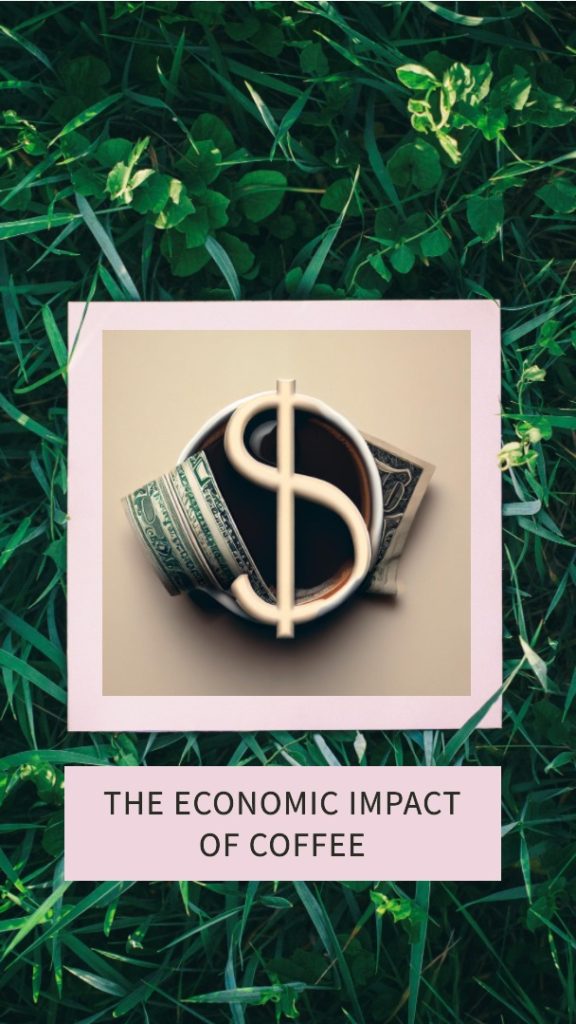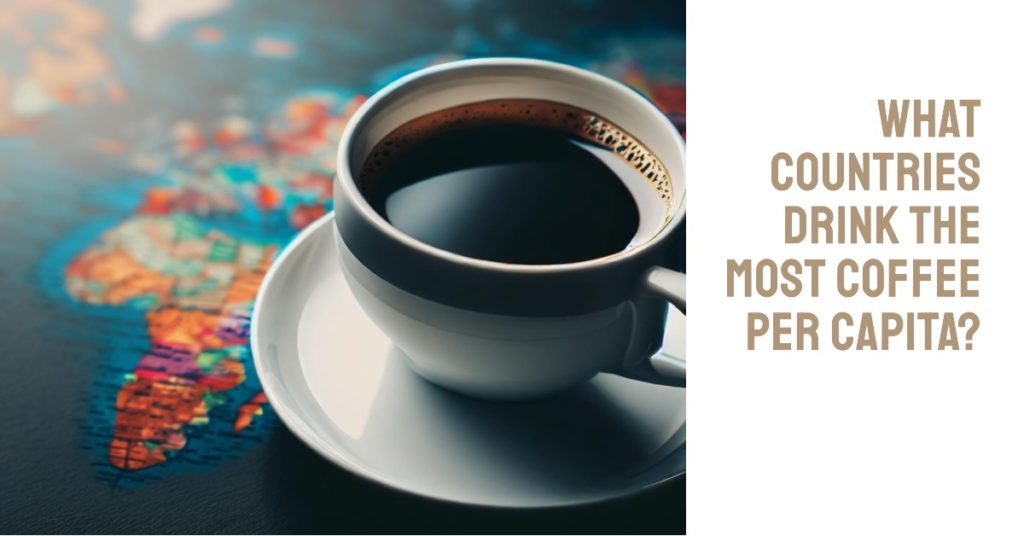There’s nothing like the aroma of freshly brewed coffee to start your day. Whether it’s a quick cup on the go or a leisurely morning ritual, for many of us, coffee is an essential part of our daily routine. But have you ever wondered what countries drink the most coffee per capita? As a caffeine addict myself, I was curious to find out.
After some research, I discovered some surprising results. From Scandinavia to South America, there are some countries where coffee consumption is through the roof!
So, if you’re a coffee lover like me, grab a cup of your favorite brew, and let’s take a caffeine-fueled journey to find out which countries come out on top in the world of coffee consumption.
Yes, some of the links might be affiliate links from Amazon and other websites. But there are no added costs to anyone who buys anything from these sites. See more details in my privacy policy.
What countries that drink the most coffee – table
| Country | Coffee consumption per capita (kg) | Coffee consumption per capita (lbs) |
|---|---|---|
| Finland | 13.2 | 29.0 |
| Norway | 10.4 | 22.9 |
| Iceland | 9.5 | 20.9 |
| Denmark | 9.1 | 20.1 |
| Netherlands | 8.8 | 19.4 |
| Sweden | 8.6 | 18.9 |
| Switzerland | 8.3 | 18.3 |
| Belgium | 7.1 | 15.7 |
| Luxembourg | 6.9 | 15.2 |
| Canada | 6.7 | 14.8 |

In this blog post we will look at the following:
Which Country Drinks the Most Coffee 2025 – Top Coffee consumption Around the World
Before we look into what countries drink the most coffee, let us talk about the general consumption. Chances are, that right now you are enjoying a cup of coffee. Coffee is one of the most popular beverages in the world.
According to the International Coffee Organization, over 166 million bags of coffee were consumed globally in 2022. The top coffee-consuming regions in the world are Europe, the Americas, and Asia.
In short, the countries that drink the most coffee is:
- Europe, coffee is a staple in many countries, with Italy, France, and Spain being the largest consumers.
- In the Americas, the United States, Canada, and Brazil are the top coffee-consuming countries.
- In Asia, Japan and South Korea are the largest consumers.
Looking for something new for yourself or a friend? Head to my post: 25 Best Gifts For Coffee Snobs Under $100!
Top 10 countries with the highest coffee consumption per capita
Coffee is a beloved drink all over the world, but some countries consume it more than others. The amount of coffee consumed per person varies depending on factors such as culture, tradition, availability, and preference. Here are the top 10 countries with the highest coffee consumption per capita in 2024, in kilograms:
- Finland: The Nordic country tops the list with an impressive 13.2 kg (29 lbs) of coffee consumed per person per year. Finns love their coffee so much that they have two mandatory coffee breaks at work every day. Coffee is also served at social gatherings and family events.
- Norway: Another Nordic country that ranks high on the list is Norway, with 10.4 kg (23 lbs) of coffee consumed per person per year. Norwegians prefer filter coffee, which they drink throughout the day and night. Coffee houses are popular places to socialize and relax in Norway.
- Iceland: Iceland comes in third place with 9.5 kg (21 lbs) of coffee consumed per person per year. Icelanders enjoy strong and dark coffee, often brewed with a French press or a Moka pot. Coffee is offered to every visitor as a sign of hospitality and friendship in Iceland.
- Denmark: Denmark ranks fourth with 9.1 kg (20 lbs) of coffee consumed per person per year. Danes have a tradition of kaffeslabberas, which means an informal social gathering where coffee and cake are served, usually after dinner or on special occasions.
- Netherlands: The Netherlands is fifth on the list with 8.8 kg (19 lbs) of coffee consumed per person per year. Dutch people drink mostly filter coffee, which they sip slowly and enjoyably. Coffee is also an essential part of breakfast and lunch in the Netherlands.
- Sweden: Sweden is sixth on the list with 8.6 kg (19 lbs) of coffee consumed per person per year. Swedes have a custom of fika, which means a break from work or daily activities to have coffee and a sweet treat, often with friends or colleagues. Fika is considered a vital part of Swedish culture and lifestyle.
- Switzerland: Switzerland is seventh on the list with 8.3 kg (18 lbs) of coffee consumed per person per year. Swiss people like to drink espresso, cappuccino, or latte macchiato, which they often accompany with chocolate or pastries. Coffee is also a common drink at business meetings and social events in Switzerland.
- Belgium: Belgium is eighth on the list with 7.1 kg (16 lbs) of coffee consumed per person per year. Belgians prefer strong and flavorful coffee, which they brew with a variety of methods, such as drip, French press, or Moka pot. Coffee is also a popular ingredient in Belgian cuisine, especially in desserts and sauces.
- Luxembourg: Luxembourg is ninth on the list with 6.9 kg (15 lbs) of coffee consumed per person per year. Luxembourgers enjoy espresso, cappuccino, or latte macchiato, which they often pair with croissants or cakes. Coffee is also a common drink at work and leisure in Luxembourg.
- Canada: Canada is tenth on the list with 6.7 kg (15 lbs) of coffee consumed per person per year. Canadians love their coffee, especially drip coffee, which they drink throughout the day. Coffee shops are ubiquitous in Canada, where people go to work, study, or socialize over a cup of joe.
The cultural significance of coffee in these countries
In my post about which country drinks the most coffee, I wanted to look closer into the impact of coffee in other ways than just thinking of it as a drink.
Coffee has a deep cultural significance in many of these countries. In Finland, for example, coffee is often served during social gatherings and is seen as a way to connect with others. Similarly, in Norway, coffee is often served alongside traditional Norwegian foods such as waffles and is seen as a way to bring people together.
In Sweden, the concept of fika, or a coffee break, is an important part of Swedish culture. Fika is a time to relax and connect with others over a cup of coffee and a pastry. In Denmark, coffee is often enjoyed as part of hygge, a concept of coziness and contentment.
The economic impact of coffee in these countries

Like we learned in the article about coffee from Africa, coffee plays an important role in the economies of many of these countries.
For example, in Colombia, coffee is a major export, and the country is the third-largest coffee producer in the world. In Brazil, coffee is the largest export, and the country is the largest coffee producer in the world.
In Ethiopia, coffee is a major source of income for farmers, and the country is the birthplace of coffee. Similarly, in Vietnam, coffee is a major export, and the country is the second-largest coffee producer in the world.
Now, these are some of the coffee producing countries. How about the impact on the local marked in the consuming countries?
Which Country Drinks the Most Coffee – Local Economic Impact
Additionally, in the Netherlands, known for its coffee culture, the coffee industry has significant economic implications. The country is renowned for its expertise in coffee trading and roasting, playing a vital role in the global coffee market.
In Germany, coffee consumption is deeply ingrained in the culture, with a vibrant coffeehouse scene and a strong coffee industry. Germany is not only one of the top consumers of coffee but also a significant player in the coffee trade, fostering economic growth and employment opportunities.
In Italy, coffee holds a special place in daily life, with a rich tradition of espresso and café culture. The country is famous for its coffee exports, especially high-quality blends and espresso machines. The coffee industry in Italy contributes significantly to the economy through domestic consumption, tourism, and international trade. Make sure you read my Best Italian Coffee Machine Reviews here
Sweden is another country where coffee consumption and economic impact go hand in hand. Swedes are among the top coffee consumers globally, and coffee breaks are an integral part of their social fabric. The thriving coffee industry in Sweden includes coffee roasters, cafés, and retailers, contributing to economic growth and employment.
In Finland, coffee has become a cultural phenomenon, and Finns rank among the highest coffee consumers per capita. The coffee industry plays a vital role in the Finnish economy, from coffee imports and retail to coffee-related tourism. Finnish coffee culture has even inspired unique events and initiatives, such as coffee festivals and competitions, further boosting the economic impact.
Norway, too, has a strong coffee culture, with Norwegians being avid coffee enthusiasts. The country has a flourishing coffee industry, encompassing coffee roasting, café chains, and specialty coffee shops. Norway’s coffee scene not only supports the local economy but also promotes sustainability and ethical practices within the industry.
The United States, despite being a vast consumer market, also boasts a significant coffee industry. With its coffeehouse chains, specialty coffee shops, and growing interest in artisanal coffee, the United States stimulates both domestic consumption and international trade. The coffee sector contributes to the country’s economy through job creation, retail sales, and coffee-related tourism.
These examples illustrate the profound economic impact that coffee has in various countries around the world. From coffee production and exports to local consumption, tourism, and industry-related businesses, coffee fuels economic growth, employment, and trade, making it a pivotal element in these nations’ economies.
Health benefits and risks of coffee consumption
While coffee is a beloved beverage, it’s important to consider both the health benefits and risks of coffee consumption. On the one hand, coffee has been linked to a reduced risk of Parkinson’s disease, liver disease, and type 2 diabetes.
On the other hand, excessive coffee consumption can lead to caffeine overdose, which can cause symptoms such as rapid heartbeat, anxiety, and insomnia. Additionally, some people may be more sensitive to the effects of caffeine and may experience negative side effects such as headaches, jitters, and digestive issues.
Check out the true story about where does coffee originate from. A coffee history in 3 parts.
The rise of specialty coffee and its impact on coffee consumption
In recent years, there has been a rise in specialty coffee, which is often sourced from small, independent farms and roasted in small batches. Specialty coffee is typically higher in quality and is often more expensive than traditional coffee.
The rise of specialty coffee has led to a renewed interest in coffee and has led to an increase in coffee consumption in some countries. Additionally, the rise of specialty coffee has led to a greater appreciation for the craft of coffee roasting and has led to the development of new brewing methods and techniques.
How coffee consumption affects the environment
Coffee production can have a significant impact on the environment. For example, coffee farming can lead to deforestation, soil erosion, and water pollution. Additionally, coffee production can be resource-intensive, requiring large amounts of water and energy. Like here in Honduras, people say it is getting warmer due to less forest and plants. On the other hand, it brings in more money in the neighborhood.
However, some coffee companies are taking steps to reduce their environmental impact. For example, some coffee companies are sourcing coffee from sustainable farms and using sustainable packaging materials. Additionally, some coffee companies are investing in renewable energy and water conservation technologies.
Coffee industry trends and future projections
Looking to the future, the coffee industry is expected to continue to grow, especially with the impact of coffee 2.0. According to a report by Research and Markets, the global coffee market is expected to reach $102.15 billion by 2025. Additionally, the rise of specialty coffee is expected to continue, with more consumers seeking high-quality, ethically sourced coffee.
Check out our post on creating your own coffee brand.
In terms of sustainability, the coffee industry is expected to continue to focus on reducing its environmental impact. Additionally, the industry is expected to focus on improving the livelihoods of coffee farmers and workers, with a greater emphasis on fair trade and ethical sourcing.
We are not only into the taste of different coffee beans and ways to brew or serve them. Another trend in the global coffee market is the rise of mushroom coffee. More and more are interested in the positive benefits provided.
Conclusion – What Countries Drink The Most Coffee 2025
Coffee is a beloved beverage that has a deep cultural significance in many countries around the world. And in this article about what countries drink the most coffee, we have seen that: From Finland to Canada, there are some countries where coffee consumption is through the roof.
While coffee has both health benefits and risks, it’s clear that coffee will continue to be a staple in many people’s lives for years to come.
As the coffee industry continues to evolve, it’s important to consider the impact of coffee consumption on both the environment and the people involved in its production.
FAQ – Which Country Drinks the Most Coffee
What is considered the best coffee in the world?
The answer to this question is subjective and can vary depending on personal preferences. However, some countries are renowned for producing high-quality coffee. Ethiopia, Colombia, Brazil, Jamaica, and Costa Rica are often recognized for producing exceptional coffee beans.
Where is a cup of coffee most expensive?
The cost of a cup of coffee can vary significantly depending on factors such as location, quality, and preparation method. Generally, countries with a higher cost of living tend to have more expensive coffee. Cities like Zurich, Oslo, Copenhagen, and Helsinki are often cited as places where coffee prices can be relatively high.
Is there any culture that doesn’t drink coffee?
While coffee is popular worldwide, there are some cultures where tea or other beverages are more prevalent. For example, in countries like China, Japan, and the United Kingdom, tea is deeply ingrained in their cultural traditions and often preferred over coffee. However, it’s important to note that coffee consumption has been on the rise globally, and it is becoming more widespread.
Which country drinks the least coffee?
Among the countries with lower coffee consumption, tea-drinking nations like China, Japan, and South Korea tend to have lower coffee consumption rates per capita. Additionally, countries with limited access to coffee or cultural preferences for other beverages may also have lower coffee consumption levels.
Why do Americans drink so much coffee?
Coffee has become deeply ingrained in American culture and daily routines. There are several reasons why Americans have a high coffee consumption rate. Firstly, the fast-paced lifestyle and demanding work culture often lead people to rely on coffee as a source of energy and focus. Additionally, the proliferation of coffee chains, such as Starbucks, has made coffee easily accessible and popular. Finally, the social aspect of meeting friends or colleagues over a cup of coffee has contributed to its widespread consumption in the United States.

